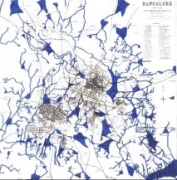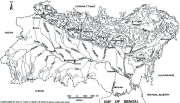Rivers
Surface and groundwater quality studies in Ghataprabha representative basin - A research report by National Institute of Hydrology
Posted on 21 Jun, 2010 01:15 AMThe study analyses the surface and groundwater quality of Ghataprabha representative basin during pre-monsoon and post-monsoon seasons. It looks at the primary impact of land use and cropping pattern on water quality using physico-chemical analysis, geo-chemical classification of groundwater samples and monitoring of groundwater quality.
Streeter-Phelp’s model is applied to understand the variation of dissolved oxygen along the course of the river from a point source. The study attempts to understand the impact of irrigation return-flow and use of pesticides, fertilizers & manures on surface and groundwater quality. The literature review offered indicates a dearth of studies on the subject for hard rock catchments and puts forward the need to do basin-wide as against area-wide studies.
Estimation of irrigation return flow in Lokapavani area of KR Sagar command in Karnataka - A research report by National Institute of Hydrology
Posted on 21 Jun, 2010 12:22 AMThe study deals with the estimation of hydrological soil properties of the area of Lokapavani River in KR Sagar Command in Mandya district of Karnataka. The properties determined are soil texture, porosity, saturated hydraulic conductivity, specific gravity and soil moisture characteristics.
The disturbed and undisturbed soil samples from eighteen locations along different depths were collected and analyzed. Eighty-five disturbed soil samples were used to determine the grain size distribution, porosity, specific gravity and soil moisture characteristic curves with the help of electromagnetic sieve shaker, master sizer, GeoPyc and pressure plate apparatus. Twenty undisturbed soil samples were used to determine saturated hydraulic conductivity with ICW Permeameter.
Surface water quality assessment of river Kali with special emphasis on non point source of pollution – A research report by the National Institute of Hydrology
Posted on 20 Jun, 2010 11:52 PMThe study conducts an extensive water quality survey in sixteen reaches of Kali river in western Uttar Pradesh to estimate the inflow of two major nutrients (nitrate and phosphate) from point and non-point sources. The study intends to validate the present model based on the principle of conservation of mass and reaction kinetics phenomenon.
Data was taken for one annual cycle on a monthly basis and criteria developed to compute the non point source load from nine sub-basins in various stretches of the river. The computed loads at each section obtained from the predictive equation have been compared with the values observed in the field. The performance of the developed equation has been evaluated using percentage error estimation and correlation statistics. Remote sensing and geographical information systems (GIS) have been used to develop correlation between basin characteristics and non-point source loads.
Tairne wala samaj doob raha hai: An essay by Anupam Mishra on the Bihar Floods
Posted on 18 Jun, 2010 09:55 PMSmall and big dams and big embankments were constructed in this region, without understanding the nature of the rivers which have always changed course or overshot their banks. Assuming however, that the river will not change course, the Government adopted a skewed development program - that of building embankments to contain the river.

Renukaji Dilli Ke Nalon Mein - A documentary about the movement against the proposed Renukaji Dam Project
Posted on 18 Jun, 2010 05:22 PMThe Renuka Dam Project proposed over the river Giri Ganga (a tributary of the Yamuna) located some 300km away from Delhi, is a joint project of the governments of Himachal Pradesh (HP) and Delhi, to be constructed by the Himachal Pradesh Power Corporation Limited (HPPCL) in Sirmaur district of HP.

Historical evolution of tank system in Bangalore city - A presentation
Posted on 12 Jun, 2010 05:54 PM The presentation from the ENVIS - CES (IISc) website, emphasises the important role that the tank system has played in the development of the city of Bangalore and highlights:
The presentation from the ENVIS - CES (IISc) website, emphasises the important role that the tank system has played in the development of the city of Bangalore and highlights:
- The principles behind the working of the tank system
- The process of evolution of the tank system with respect to the growth of the city
- The underlying planning principles that were used in the tank system
- The role and importance of water tanks as an asset to the city
- The relationship between the system of tanks and the city of Bangalore
- The usefulness of the tanks as an important source of drinking water and agriculture in lean periods
Water quality status of rivers Tungabhadra, Cauvery and Kabini - KSPCB (2007)
Posted on 12 Jun, 2010 01:36 PMThese two documents from the KSPCB website, provide monthly water quality status data, for the rivers Tungabhadra, Cauvery and Kabini, monitored between January to June 2007, at various points along the rivers.
The data recorded are Temperature, pH, Dissolved Oxygen (DO), Biochemical Oxygen Demand (BOD), Chemical Oxygen Demand (COD) and Faecal Coliform.
Draft of “The Dam Safety Bill, 2010” approved
Posted on 08 Jun, 2010 06:24 PMAs per the Press Information Bureau's press release, the Union Cabinet has approved the proposal of the Ministry of Water Resources for enacting The Dam Safety Bill, on May 13 2010. The Bill is to be introduced in the Parliament.
The main objectives of the legislation are:-
• The new legislation will help the States in adopting uniform dam safety procedures which shall ensure safety of dams and safeguard benefits from such dams.
Dams on Himalayan rivers: How good is the science?
Posted on 08 Jun, 2010 05:38 PMThis brief article by Prof Jayanta Bandyopadhyay in the May 16-31 2010 issue of Business Economics magazine, highlights the recent plans of the central and state goverments of constructing a large number of dams on Himalayan rivers. Environmentalists continue to consistently argue against the construction of dams that are built without respect for ecological sciences and warn that this could lead to increase in disasters in the fragile Himalayan region.
Holistic Engineering and Hydro-Diplomacy in the Ganges-Brahmaputra-Meghna Basin - EPW Paper
Posted on 23 May, 2010 04:49 PM This document by Jayanta Bandyopadhyay, highlights the importance of the Ganges-Brahmaputra-Meghna (GBM) basin as an important source of water for many of the countries in South Asia, and the crucial role of negotiations in the context of the impending water crisis threatening the basin with the phenomenon of climate change.
This document by Jayanta Bandyopadhyay, highlights the importance of the Ganges-Brahmaputra-Meghna (GBM) basin as an important source of water for many of the countries in South Asia, and the crucial role of negotiations in the context of the impending water crisis threatening the basin with the phenomenon of climate change.
The document argues that traditional water engineering has been found to be highly reductionistic and ineffective in bringing about development in the GBM basin and the continuing poverty in the GBM basin can be linked to the absence of a holistic ecological perspective, use of an incomplete framework for economics and ignoring of long-run economic costs of the actions proposed.




